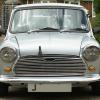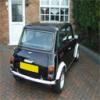Powercaps
Power caps are misunderstood things.
Many people believe that adding a cap will stop your lights dimming, make your system louder and add about 13bhp to your engine (...probably).
First, let's see what a capacitor is.
http://electronics.h...m/capacitor.htmTo summarise, a capacitor is similar to a battery, in that it stores electrical enegy. A good analogy used is:
One way to visualize the action of a capacitor is to imagine it as a water towerhooked to a pipe. A water tower "stores" water pressure -- when the water system pumps produce more water than a town needs, the excess is stored in the water tower. Then, at times of high demand, the excess water flows out of the tower to keep the pressure up. A capacitor stores electrons in the same way and can then release them later.
So all that caps do is store a small amount of energy, which is then released when required, the rest of the time it is charging.
When NOT to use a power cap:If when listening to your system with engine on, a bass note hits and your lights dim and stay dim, you should not get a power cap. You should instead upgrade "the big three" - either a bigger battery (or a second battery), uprated cabling and/or a more powerful alternator.
When to use a power cap:If when listening to your system with engine on, a bass note hits and your lights dim and return to full brightness immediately, then a power cap can help your system.
So a power cap can work in theory. But how well? Well I'm sure at some point you've used a camera with the flash on. The flash is powered through a capacitor too. But when you've just taken a photo, do you have to wait for a good few seconds before the camera does anything? Because at the moment the
flash goes boom, the circuit's 'output' (in this case converting electrical energy into heat and light energy) section increases suddenly, and the 'waiting time' is the battery recharging the capacitor.
But this is controlled by the camera's software, and limits you from taking a photo to every few seconds, as otherwise the flash would just be a measly candle flash.
But similarly, in car audio, when the current demand suddenly rises (ie: when the bass hits, to convert electrical energy into mechanical energy and then acoustic energy) the first line of defence is the amplifier's on-board capacitor bank, which smooths a lot of the draw.
Outside of this, you'll be looking at the power supply sections: battery, alternator, and your capacitor.
For those who don't know, the alternator works by being driven by the aux belt and converting mechanical energy into electrical energy, stored in the battery.
So bass hits, first few beats... power cap helps a bit. But when the stored energy depletes? The alternator's busy charging the battery, and all the battery's power is going into your amp which is making your 18" MegaBass sub and making Kylie sound like thunder.... it's not re-charging your power cap. The electricity is just going straight through it. So you'd be better off spending your money on a bigger battery and alternator.... assuming that your cabling is up to scratch.
If you're really that adamant about it, then buy one and test it... and trust me, your headlights will dim both before and after.
Rob.
PS: "But my voltmeter reads about 14 volts so it must be working isn't it!" No. A voltmeter measures the voltage across and given point in a circuit. You can stick it over your battery, across a random length of cabling, or anywhere you like - it'll still read the same. They just pop one on the power capacitor to make it look like it's doing something. What you want it an ammeter





















